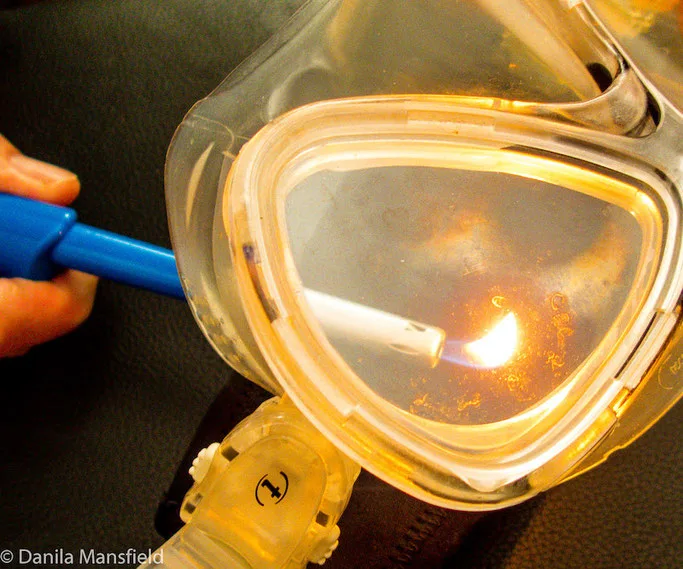Why do I need to clean a brand new mask, what’s dirty about it? Well, it’s one of those little secrets that manufacturers and diveshops don’t always mention, but during the manufacturing process a film of silicone and mould release agents forms on the surface of your brand new mask lens. This film is stubbornly resistant to the usual de-fogging methods of spit, baby shampoo or commercial defogger, and if you don’t clean it off you’ll have some frustratingly foggy dives.
But what to use? We’ve heard stories of toothpaste, and burning with lighters! Fortunately the great community of Girls That Scuba have many new masks’ worth of experience to call upon, and here’s a round-up of tried and tested suggestions (plus a few wacky ones!)
Pre dive Treatments
Before you dive, we recommend that you do something to remove the silicone film on your mask lens, something more than the spit or shampoo treatment that most divers use right before getting wet. These treatments fit into two broad categories, commercial and DIY.
Commercial mask cleaners
There are a few commercial scrubs specially designed to clean scuba masks:
McNett’s Sea Buff mask precleaner
Salclear makes a number of products, some for de-fogging, and one they say is for “cleaning and preparation of new diving masks”.
Toothpaste
Use a small blob of regular white toothpaste (not gel), get comfy and rub that stuff around and around your mask. Take a short break, then get rubbing again. Put a good movie on and keep going, yes it’s tedious! You could use a cloth, or an old toothbrush too. Some GTS recommend leaving the toothpaste to dry overnight before washing it off.
Some people like a minty-smelling mask, and others find any toothpaste residue irritating to the eyes – take your pick!
Burn you mask

This is a contentious issue, with strong views on both sides!
PROS
We had lots of firm “yesses”, including from several DMs and Instructors within our Facebook group:
“As a dive instructor, other fellow dive instructors will agree, we always burn masks. That’s the first thing I ask a customer when they bring their own gear. “Is your mask new?” If it is…I burn it. You have tempered glass lenses so nothing will hurt it. Take a lighter and hold it up to the glass and move it around, you’ll see the glass starts turning black. THAT’S GOOD! That means the silicone layer that is stuck onto the glass is burning off. Once the glass is all black let it cool and wash it with dish soap or toothpaste. If it fogs on you then repeat. I once had to burn a Cressi mask 5 times.”
“Burning the film off the inside is about the only sure way to stop fogging, but you have to be VERY careful not to damage the skirting and not to apply heat too long to one spot on the lens. A lighter and a steady sweeping motion across the inside of the lens takes care of it.”
“I think every mask is different. For my current mask, toothpaste wasn’t enough and I had to do a lot of burning. I just huffed into the mask after each burn and I could see where it still needed it. Now my mask works great.”
Is it safe?
Several GTS members tell us:
“The only way a heat to the lens will damage the tempering is to have it be far hotter than a lighter or match gets, as well as be left there for extended periods. It’s the same principal why windows don’t blow out of a structure that’s on fire, tempering is made to keep it from happening until it reaches serious temperatures.”
CONS
On the other hand, there were many warnings about safety risks, and the possibility of voiding the manufacturers’ warranty:
From undercurrent.org. “Don’t Flame Your Mask April 12, 2018 –
Last month, we reported to our subscribers that a few Hollis masks had shattered when a diver hit the water, and now we have found the culprit: not the mask, but the diver. As you know, you must polish the inside surface of a new mask to remove the coating and prevent it from fogging. However, some divers try to burn off that coating with a cigarette lighter, but this can weaken the tempered glass and may result in a frameless single face-plate mask shattering on impact with the water, especially if the strap is pulled so tight it stresses the weakened glass. The proper way to remove the film is to polish the glass with a gentle abrasive such as old-fashioned white toothpaste.”
“The suggestion of burning the film is fast and easy, but not any more effective than removing the film any other way. Unfortunately, burning both cancels the manufacturer warranty, and can cause weak spots in the glass that can cause the mask to shatter.”
“Please DO NOT burn your mask. In very rare cases, that’s weakened the glass and people have had their masks shatter when they’ve had some impact (e.g., doing a giant stride from a boat). It’s a very rare occurrence but why risk it?”
“I’m surprised any professional would do this, simply because it opens them up to a whole lot of liability.”
“Do NOT burn- I’ve had three people in as many weeks bring masks back that were warped from a lighter.”
More tips and tricks
There were a few other suggestions that were only mentioned once or twice, so they don’t appear to be as widely-used as those above. If you’ve tried any of these methods, please comment below how well it worked for you!
- Use lots of salt and a tiny bit of water to make a thick paste, rub around with your finger for a while. Salt will slowly dissolve, then rinse out.
- Rub with honey.
- Rub with a raw potato. (really?)
- Soak overnight in cola. Don’t use diet or caffeine-free.
- Rub the lens with a bit of ash plus a tiny bit of water for a while.
- In Mexico on the boat they had borax and put a little inside scrubbed to get the film off and not had an issue since.
- Mr Clean eraser.
- Commercial kitchen/bath cleaners. If you decide to try one of these, please be careful to rinse your mask very carefully, as many of these include bleach.
Read also: Mask cleaning skill – we show you how to do it
Before each dive
Do you spit or shampoo?
Prep your mask with your product of choice. This could be spit, spray bottle of baby shampoo diluted in water, or commercial defogger. If you use shampoo, please check if it’s reef safe. Stream2Sea make some great products!
The GTS community seems to be pretty much split down the middle on what to use. Although the product might be different, the consensus on method seems to be:
- Apply a thin film of spit (your own or a handy buddy’s!) or diluted shampoo (baby/no tears shampoo is a favourite), smeared onto the DRY lens.
- Leave the film of spit or product for up to a couple of minutes.
- Finally, give the mask a very quick rinse with either fresh or salt water, depending on availability. If you use the communal rinse bucket on the dive boat, please don’t use the camera bucket, and please don’t dunk your mask, just use your hand to scoop out some water into your mask – let’s be kind to our fellow divers!
Fogging during a dive?
This is a tricky one. A couple of GTS suggested rubbing the inside of your mask with kelp or seaweed. I’ve been given that recommendation myself, and if you’re comfortable taking your mask off underwater, it’s worth a shot. I had some bad mask fogging one day, and tried rubbing it with seaweed, it might have helped a bit, but I can’t say it was a surefire fix. Best to perfect your prevention techniques.
And finally:
Dear mask manufacturers, could you please remove the silicone film before selling your masks?

About the Author
Even though she’s not a strong swimmer, and never liked to put her face in the water, Danila Mansfield has been a recreational diver since 1996, and it is truly her happy place! She has been a full-time nomad since 2013, and blogs about it at Notdunroamin.

